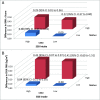Beverage Intake During Pregnancy and Childhood Adiposity
- PMID: 28689188
- PMCID: PMC5527670
- DOI: 10.1542/peds.2017-0031
Beverage Intake During Pregnancy and Childhood Adiposity
Abstract
Objectives: To examine associations of sugar sweetened beverages (SSBs) and other beverage intake during pregnancy with adiposity in midchildhood (median age of 7.7 years).
Methods: We studied 1078 mother-child pairs in Project Viva, a prospective prebirth cohort study. Exposures were sugary and nonsugary beverage intake assessed in the first and second trimesters of pregnancy by using a food frequency questionnaire. Main outcome measures were offspring overall adiposity (BMI z score, fat mass index [FMI, kg/m2] from dual-energy radiograph absorptiometry, and sum of subscapular [SS] and triceps [TR] skinfold thicknesses) and central adiposity (SS:TR ratio and waist circumference).
Results: In the second trimester, mean (SD) SSB intake was 0.6 (0.9) servings per day. Thirty-two percent of mothers were multiracial or people of color, 68% were college graduates, and 10% smoked during pregnancy. In midchildhood, mean (SD) BMI z score was 0.38 (1.00), and the FMI was 4.4 (1.9) kg/m2. In multivariable models adjusted for multiple maternal and child covariates, each additional serving per day of SSB was associated with higher BMI z scores (0.07 U; 95% confidence interval [CI]: -0.01 to 0.15), FMI (0.15 kg/m2; 95% CI: -0.01 to 0.30), SS + TR (0.85 mm; 95% CI: 0.06 to 1.64), and waist circumference (0.65 cm; 95% CI: 0.01 to 1.28). Stratified models suggested that the associations were due primarily to maternal, not child, SSB intake and to sugary soda rather than fruit drinks or juice. We did not find differences between boys and girls, nor did we observe the effects of sugar-free soda or of first-trimester beverage intake.
Conclusions: Higher SSB intake during the second trimester of pregnancy was associated with greater adiposity in midchildhood.
Copyright © 2017 by the American Academy of Pediatrics.
Conflict of interest statement
POTENTIAL CONFLICT OF INTEREST: The authors have indicated they have no potential conflicts of interest to disclose.
Figures

Similar articles
-
Prenatal and Early Life Fructose, Fructose-Containing Beverages, and Midchildhood Asthma.Ann Am Thorac Soc. 2018 Feb;15(2):217-224. doi: 10.1513/AnnalsATS.201707-530OC. Ann Am Thorac Soc. 2018. PMID: 29219619 Free PMC article.
-
Mothers' intake of sugar-containing beverages during pregnancy and body composition of their children during childhood: the Generation R Study.Am J Clin Nutr. 2017 Apr;105(4):834-841. doi: 10.3945/ajcn.116.147934. Epub 2017 Mar 8. Am J Clin Nutr. 2017. PMID: 28275130
-
The Role of Prenatal Psychosocial Stress in the Associations of a Proinflammatory Diet in Pregnancy With Child Adiposity and Growth Trajectories.JAMA Netw Open. 2023 Jan 3;6(1):e2251367. doi: 10.1001/jamanetworkopen.2022.51367. JAMA Netw Open. 2023. PMID: 36662527 Free PMC article.
-
Substituting sugar-sweetened beverages with water or milk is inversely associated with body fatness development from childhood to adolescence.Nutrition. 2015 Jan;31(1):38-44. doi: 10.1016/j.nut.2014.04.017. Epub 2014 May 9. Nutrition. 2015. PMID: 25441586 Review.
-
Sugar-sweetened beverages intake and the risk of obesity in children: An updated systematic review and dose-response meta-analysis.Pediatr Obes. 2022 Aug;17(8):e12914. doi: 10.1111/ijpo.12914. Epub 2022 Apr 24. Pediatr Obes. 2022. PMID: 35466543
Cited by
-
Associations of Maternal Consumption of Sugary Beverages in Pregnancy With Infant Weight Status.Acad Pediatr. 2023 Jan-Feb;23(1):109-116. doi: 10.1016/j.acap.2022.05.007. Epub 2022 May 13. Acad Pediatr. 2023. PMID: 35577285 Free PMC article.
-
Trends in Low-Calorie Sweetener Consumption Among Pregnant Women in the United States.Curr Dev Nutr. 2019 Jan 15;3(4):nzz004. doi: 10.1093/cdn/nzz004. eCollection 2019 Apr. Curr Dev Nutr. 2019. PMID: 30931427 Free PMC article.
-
Nonnutritive Sweeteners in Weight Management and Chronic Disease: A Review.Obesity (Silver Spring). 2018 Apr;26(4):635-640. doi: 10.1002/oby.22139. Obesity (Silver Spring). 2018. PMID: 29570245 Free PMC article. Review.
-
Analyzing Policies Through a DOHaD Lens: What Can We Learn?Int J Environ Res Public Health. 2018 Dec 19;15(12):2906. doi: 10.3390/ijerph15122906. Int J Environ Res Public Health. 2018. PMID: 30572594 Free PMC article.
-
Parental and Provider Perceptions of Sugar-Sweetened Beverage Interventions in the First 1000 Days: A Qualitative Study.Acad Pediatr. 2019 Sep-Oct;19(7):748-755. doi: 10.1016/j.acap.2019.01.004. Epub 2019 Jan 21. Acad Pediatr. 2019. PMID: 30677540 Free PMC article.
References
-
- Gillman MW. Developmental origins of obesity In: Hu FB, ed. Obesity Epidemiology. New York, NY: Oxford University Press; 2008:399–415
-
- McMillen IC, Robinson JS. Developmental origins of the metabolic syndrome: prediction, plasticity, and programming. Physiol Rev. 2005;85(2):571–633 - PubMed
-
- Mathias PC, Elmhiri G, de Oliveira JC, et al. . Maternal diet, bioactive molecules, and exercising as reprogramming tools of metabolic programming. Eur J Nutr. 2014;53(3):711–722 - PubMed
-
- Poston L. Maternal obesity, gestational weight gain and diet as determinants of offspring long term health. Best Pract Res Clin Endocrinol Metab. 2012;26(5):627–639 - PubMed
MeSH terms
Substances
Grants and funding
LinkOut - more resources
Full Text Sources
Other Literature Sources
Medical

